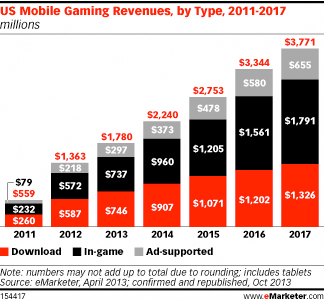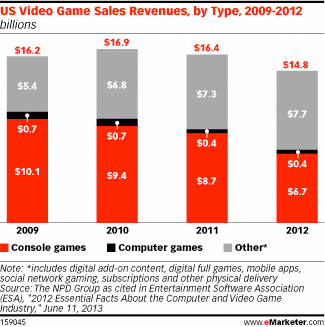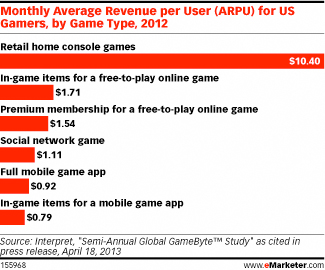Mobile Gaming Revenues lag behind other Channels
October 25, 2013
![]() eMarketer estimates the number of US mobile phone gamers will reach 125.9 million in 2013. By 2017, that number is expected to grow to 191.3 million. It’s no surprise that the video game industry, including marketers that target their audiences through gaming, now views mobile as a primary platform.
eMarketer estimates the number of US mobile phone gamers will reach 125.9 million in 2013. By 2017, that number is expected to grow to 191.3 million. It’s no surprise that the video game industry, including marketers that target their audiences through gaming, now views mobile as a primary platform.
 Although mobile gamers now make up the largest and fasting-growing segment of the gaming population, mobile gaming revenues still lag behind other channels, like console games. US mobile gaming revenues are expected to double within the next four years, rising from $1.78 billion in 2013 to more than $3.77 billion in 2017. The in-game segment, which consists of virtual goods sold within free-to-play games, will drive most of this growth.
Although mobile gamers now make up the largest and fasting-growing segment of the gaming population, mobile gaming revenues still lag behind other channels, like console games. US mobile gaming revenues are expected to double within the next four years, rising from $1.78 billion in 2013 to more than $3.77 billion in 2017. The in-game segment, which consists of virtual goods sold within free-to-play games, will drive most of this growth.
 By next year, virtual goods will contribute more revenues than full-game downloads, which up until now have been the most lucrative segment. eMarketer expects that by 2017, virtual goods will claim 47.5% of total mobile gaming revenues, up from 41.4% in 2013. Advertising’s share will also increase at the expense of paid downloads, but the segment will remain a relatively small revenue contributor.
By next year, virtual goods will contribute more revenues than full-game downloads, which up until now have been the most lucrative segment. eMarketer expects that by 2017, virtual goods will claim 47.5% of total mobile gaming revenues, up from 41.4% in 2013. Advertising’s share will also increase at the expense of paid downloads, but the segment will remain a relatively small revenue contributor.
 The NPD Group’s annual tracking of US video game sales revenues noted a significant increase in the category that includes mobile games and digital add-on content (that is, in-app virtual goods and full-game downloads). In 2012, the “other” category grew to $7.7 billion, up from $5.4 billion in 2009. By contrast, console revenues shrank from $10.1 billion to $6.7 billion during the same period. It should be noted that “other” includes all digital content, but the study did not indicate what percentage of this category came from mobile in-app virtual goods.
The NPD Group’s annual tracking of US video game sales revenues noted a significant increase in the category that includes mobile games and digital add-on content (that is, in-app virtual goods and full-game downloads). In 2012, the “other” category grew to $7.7 billion, up from $5.4 billion in 2009. By contrast, console revenues shrank from $10.1 billion to $6.7 billion during the same period. It should be noted that “other” includes all digital content, but the study did not indicate what percentage of this category came from mobile in-app virtual goods.
Although mobile games are a growing category, they also generate less average revenue per user (ARPU) than other forms of gaming. According to an Interpret study, ARPU was more than 10 times higher for console games than for full mobile games in 2012. On average, console games generated $10.40 per month per user, compared with 92 cents for a full mobile app. In-game items generated even less ARPU, at 79 cents.
These findings underscore the challenges that mobile game companies face. With each user contributing relatively small amounts of revenues, game developers and publishers are constantly under pressure to grow their audiences and compel users to spend money on virtual items. At the same time, overly aggressive in-game marketing tactics can easily turn users off, so to be successful in the future, game developers must strike a delicate balance.
Courtesy of eMarketer




























